Capital Theatre, Historical Marker
Introduction
Text-to-speech Audio
Images
The Front of the Capitol Theatre in the mid-1970s.
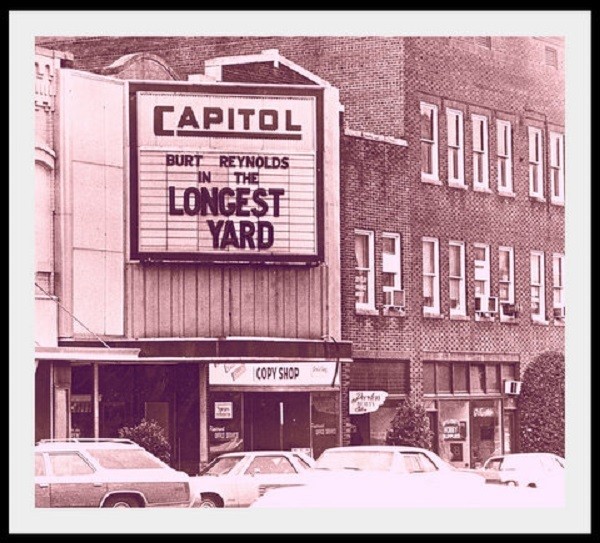
The interior of the Capitol Theatre before desegregation. Notice that Black patrons sat in the balcony area while White patrons sat in the main seating area.
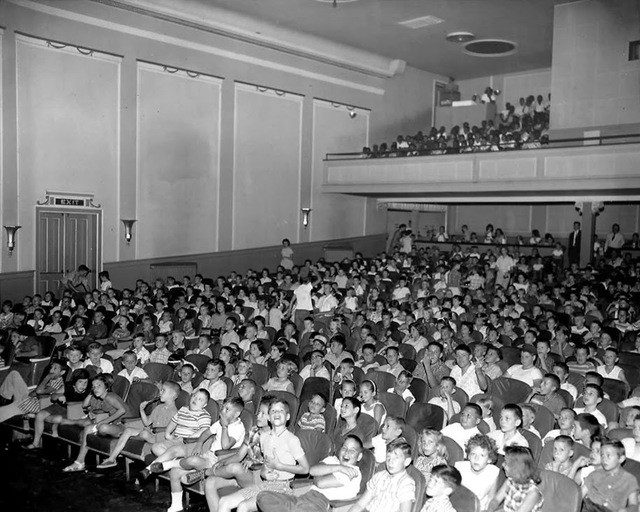
The Salisbury Post on February 1962 reporting on the student demonstrations at the Capitol Theatre.

The Salisbury Post on February 1962 reporting on the call by the Livingstone student action committee for continued demonstrations.
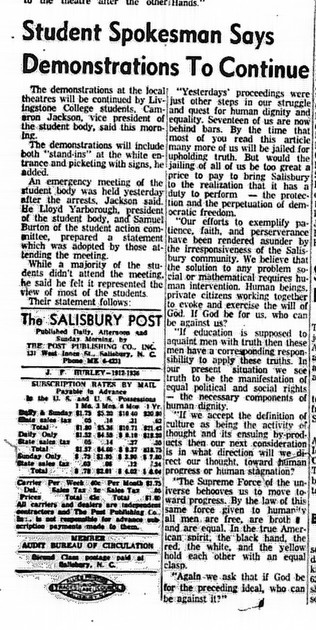
Max Yoder being arrested for Capitol Theatre demonstration.
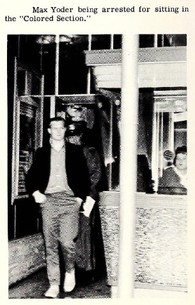
Richard Stewart, Vaughn Eason, Charles Keyes, and James Boger being arrested for Capitol Theatre demonstration.
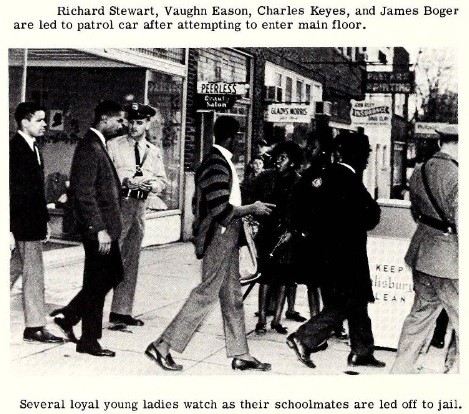
Livingstone students at the Capitol Theatre demonstrations.
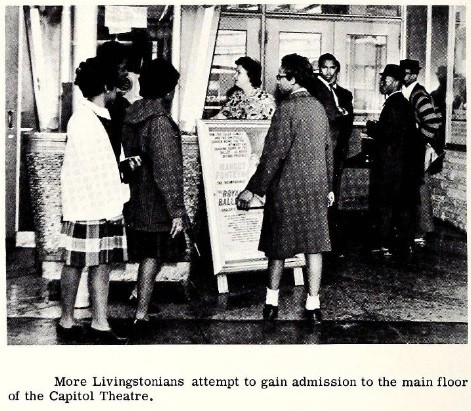
Livingstone students singing "Lift E'vry Voice and Sing" while waiting to be arrested during the Capitol Theatre demonstrations.
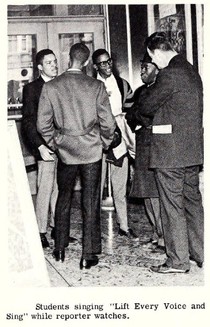
Wiley I. Lash's handwritten desegregation plan.

The back of Wiley I. Lash's handwritten desegregation plan.
.jpg)
Backstory and Context
Text-to-speech Audio
On February 28, 1962, sixteen Livingstone College students organized a demonstration against the racial segregation of Salisbury movie theaters. Described by the local newspaper “neatly dressed and restrained in manner”, Richard G. Steward and four other Livingstone students entered the Capitol Theatre.[1] The group bought tickets for the balcony but started towards the “Whites only” area before Paul V. Phillips, the manager, stopped them. Phillips obtained warrants for their arrest when the demonstrators refused to leave the theater, though they did not force their way into the theatre. Several police officers arrived to arrest all five students and another boy for trespassing. Despite not taking part in the protest, the police arrested the non-student because officers saw him talking to the students outside the theater. Officers arrested Max Yoder, a White Livingstone College student from Indiana, for sitting in the balcony area. Yoder tried to break the color barrier before at the Capitol Theatre through repeated attempts to sit with his Livingstone friends despite the efforts of theater management.
As the students waited for the police, they sang the Negro Anthem, “Lift Ev’ry Voice and Sing.”[2] First written as a poem by James Weldon Johnson in 1900, the National Association for the Advancement of Colored People (NAACP) adopted the piece as its official song when James Johnson’s brother set the poem to music. The song quickly became a popular song for demonstrations and protests during the Civil Rights Movement.[3]
Charles E. Quick, a second-year student at Hood Seminary, attempted to sit in the “Whites only” seating area shortly after the arrests of the first group of student protestors. At 9:15 pm, additional Livingstone students appeared in front of the theater with signs and posters that advocated for civil rights. A group of four students tried to sit in the area reserved for white patrons, only for the police to arrest them for trespassing like the previous protesters. Captain Kesler handled the arrest of the last six demonstrators that evening. The police arrested sixteen Livingstone students and one uninvolved person in connection to the protests at the Capitol Theatre that day. The protesters reportedly sang and prayed throughout the night in the county jailhouse, singing songs such as “We Shall Not Be Moved” and a rendition of “We’ve Got the Whole World in Our Hands.”[4]
After the arrest of the demonstrators, three African-American gentlemen arrived at the police station. John R. Kinard, a second-year student at Hood Seminary, acted as the spokesman of the group and declared that they planned to seek the counsel of the NAACP or the Fellowship of Reconciliation, an interracial religious nonviolent organization. A statement by the student action committee at Livingstone called for the continuance of the picket lines and “stand-ins” in front of local theaters.[5] On March 4, 1962, the coordinators of student protests called a halt to the demonstrations in the interest of private negotiations between theater management and African-American leaders to “exhaust all rational means of solving this social [paradox].”[6]
The arrests on February 26, 1962, marked the first civil rights arrests made in Salisbury since the start of the sit-ins in Greensboro, North Carolina in 1960. In a 2004 interview Richard G. Stewart recalled that, "Salisbury, at that time, prided itself on good race relations, and we knew they were going to select persons-not us-but prominent people in the African-American community to repeat the move."[7]
Livingstone President, Samuel E. Duncan, and prominent businessman, Wiley I. Lash took to the Capitol Theatre to the desegregate of Salisbury theaters less than a month after the initial demonstrations. The men successfully watched a movie in the “Whites only” section every day for a week. Other African-Americans citizens and students participated in the protest and occupied "Whites only" seating in various theaters across Salisbury. Theater managers lifted their racial segregation policies after six weeks of peaceful protesting. The success of the desegregation efforts stemmed from the courageous actions of student protesters and African-American leaders in the city. The desegregation process followed the carefully written plan by Wiley I. Lash, which detailed a six-week protest by adults and students. Theater managers were told who the protestors were and when they would to the theater. At the end of the six-week period, Wiley's plan called for theater managers to remove racial barriers.[8] The willingness of local leadership to engage in negotiations for a peaceful integration process marks a distinct feature in the local civil rights movement.
Sources
[1] “Seek Theater Integration: Negro Student Demonstrators Jailed Here,” Salisbury Post. 25 February 1962. Edith Clark Reading Room Microfilm Collection, Rowan County Public Library.
[2] Rose Post, "It's Time to Tell Civil Rights Story," Salisbury Post. 31 October 2004. Edith Clark Reading Room Rowan County, NC-Integration Folder, Rowan County Public Library; “Seek Theater Integration: Negro Student Demonstrators Jailed Here.”
[3] “Lift Every Voice and Sing.” PBS.org. PBS Charlotte. https://www.pbs.org/Black-culture/explore/Black-authors-spoken-word-poetry/lift-every-voice-and-sing/
[4] Post; “Seek Theater Integration: Negro Student Demonstrators Jailed Here.”
[5] “Student Spokesman Says Demonstrations to Continue.” Salisbury Post. 27 February 1962. Edith Clark Reading Room Microfilm Collection, Rowan County Public Library.
[6] “Negro Students Temporarily Halt Picketing.” Salisbury Post. 4 March 1962. Edith Clark Reading Room Microfilm Collection, Rowan County Public Library.
[7] Post.
[8] Wiley Lash Theater Integration Plan. Lash Collection, Box 1, Folder 9B. Edith Clark History Room, Rowan County Public Library.
[9] “Yesterday: Where’s the Victory Theater?” Salisbury Post, 10 April 1999. Edith Clark Reading Room Microfilm Collection, Rowan County Public Library.
Cline, Mike. Front of Capitol. 1970s. http://www.mikeclinesthenplaying.com/p/theaters.html
Cline, Mike Cline. Interior of the Capitol Theatre. 1960s. http://www.mikeclinesthenplaying.com/p/theaters.html
“Seek Theater Integration: Negro Student Demonstrators Jailed Here.”Salisbury Post. 25 February 1962. From the Edith Clark Reading Room Microfilm Collection.
“Student Spokesman Says Demonstrations to Continue.” Salisbury Post. 27 February 1962. From the Edith Clark Reading Room Microfilm Collection.
The Livingstonian. 1962. Livingstone College Archives and Special Collections, North Carolina Digital Heritage Center. https://lib.digitalnc.org/record/37830?ln=en#?c=0&m=0&s=0&cv=42&r=0&xywh=5287%2C829%2C1003%2C609
The Livingstonian. 1962. Livingstone College Archives and Special Collections, North Carolina Digital Heritage Center. https://lib.digitalnc.org/record/37830?ln=en#?c=0&m=0&s=0&cv=42&r=0&xywh=5287%2C829%2C1003%2C609
The Livingstonian. 1962. Livingstone College Archives and Special Collections, North Carolina Digital Heritage Center. https://lib.digitalnc.org/record/37830?ln=en#?c=0&m=0&s=0&cv=42&r=0&xywh=5287%2C829%2C1003%2C609
The Livingstonian. 1962. Livingstone College Archives and Special Collections, North Carolina Digital Heritage Center. https://lib.digitalnc.org/record/37830?ln=en#?c=0&m=0&s=0&cv=42&r=0&xywh=5287%2C829%2C1003%2C609
Wiley Lash Theater Integration Plan. Lash Collection, Box 1, Folder 9B. Edith Clark History Room, Rowan County Public Library.
Wiley Lash Theater Integration Plan. Lash Collection, Box 1, Folder 9B. Edith Clark History Room, Rowan County Public Library.
